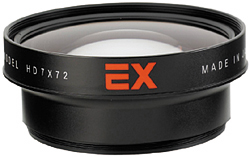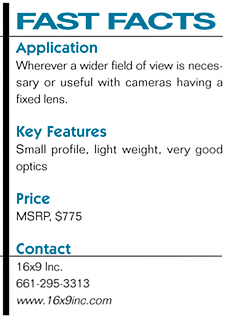16x9 EX 0.7X Wide-Angle Adapter
The ever-accelerating pace of evolution in camera technology has made it challenging and expensive to build a full toolset for a given camera. This is particularly true with regard to modern lenses, as a single wide-angle or telephoto lens can cost more than the camera itself. The economical alternative is a lens adapter—for telephoto and for wide-angle needs—which complements the standard zoom lens. If wider-angle coverage is required, it's not a major chore to attach an outboard adapter to the camera's zoom lens to widen its perspective by some 20 to 30 percent. With fisheye lens adapters this can exceed 50 percent.
For convenience, most lens adapters attach to the front element and most use the bayonet-style mount endemic to the camera. These vary from one camera and lens manufacturer to another, and often from one series of cameras to another.
The net result of this has been the need to create lens adapters which are designed to fit a particular series of cameras, and sometimes a particular camera. This means that when it comes time to switch or to add a different camera, new lens adapters must be purchased.

16x9's EX 0.7X Wide-Angle Lens Adapter This built-in obsolescence is great for lens manufacturers, but is expensive for camera and lens owners—particularly if they need both wide-angle and telephoto adapters in their toolkit.
Fortunately, one optical company, 16x9, has taken a different tack—screw-on adapters that attach to a zoom lens by the same threads used for attaching filters. Lenses are fairly standard in this respect so that filters, lens shades and other accessories can readily be acquired for a given new camera and can also be used with another camera of comparable size. Until recently, this same pragmatic principle was not widely adopted in the focal length adapters arena, particularly for smaller pro models. The net result has been an alphabet soup of lens adapters with bayonet mounts unique to one or only a few cameras.
16x9 Inc. decided to take the same approach to mounting lens adapters as used by lens filter manufacturers—standard sized screw-on threaded mounts. The goal is to enable the same adapters to be used with many different cameras, and to migrate with the owner from camera to camera, rather than being transferred from one camera owner to another along with the camera itself.
FEATURES
16x9 Inc. offers a full selection of lens adapters for most current pro camcorders, including two wide-angle models, a 0.7X and a 0.75X for 1/3-inch CCD camcorders. Both screw into the camcorder lens via the standard filter threads at the outer element of all lenses. For many pro 1/3-inch CCD camcorder lenses the filter ring diameter is 72 mm, allowing interchange of not only filters, but also the same 16x9 lens adapters. The company's 72 mm 0.7X and 0.75X adapters can also be mounted on 62 mm camcorder lenses with the use of a stepdown adapter ring.
Unlike typically hefty wide-angle adapters made for full-sized 2/3-inch CCD camcorders, 16x9's, new EX 0.7X has only three multicoated optical elements. As a result, it's fairly compact and lightweight—only 1.25-inches thick and weighing slightly less than a pound. This small addition limits the forward shift in horizontal balance when the adapter is added, particularly when the camcorder is tripod-mounted.
This is characteristic of 16x9's new EX series of lens adapters. Their EX 0.7X is 25 percent lighter, and 20 percent shorter than the first generation of 0.7X adapters. Its comparative lightness and compactness are geared to improving its suitability for handheld work by reducing frontal loading, thus maintaining camera balance on the shoulder as well as on a tripod.
Also, the wide corner modulation transfer function (MTF) has been improved by 30 percent, and there's been a 50 percent improvement in telephoto MTF, according to 16x9. The net result is images with sharper contrast, better resolution and less color aberration.
A hardened rubber lens hood is available and recommended for use with most 16x9 lens adapters including the 0.7X size. The accessory serves as an unobtrusive sunshade, and also provides physical protection from inadvertent and advertent physical contact between the lens adap-ter and physical hazards that threaten lenses.
IN USE
The package containing the adapter seemed surprisingly light, as if the lens adapter somehow didn't get packed. And the box also seemed too small to contain a multi-element optic unit. However, the adapter is constructed around only three elements and is very compact.
Attaching it was fairly straightforward, as there's only one possible end to screw in and only one logical place to attach it. However, the prospect of cross-threading and ruining threads is very real for both the adapter and the lens, so I took it slow and easy. It went on without a hitch and everything looked perfect in the viewfinder. Attaching the lens shade to the adapter was similar, but without the consequences of bobbling some precision cut threads. In barely five minutes my camera's perspective had broadened and I was ready to begin capturing video with a window on the world suddenly 30 percent wider.
Even though I had only added a pound, the XH A1 did feel a bit heftier and more stable in my hand and on my shoulder. The difference, although negligible, seemed to make it a bit easier to hold the camcorder steady on the shoulder and in other positions.
Much the same applied when I snapped the package onto an FS 6 head on a Sachtler tripod, which was pre-balanced for use with the solo Canon XH A1. After a quick leveling of the head, no adjustment was needed to keep the lens end from dipping downwards. However, as a precaution I slid the tripod's horizontal adjusting plate backwards a couple of inches. Then I was able to leave the camcorder unattended without fear of it tilting forwards or backwards.
The biggest initial challenge was making the adjustment to the reduced minimum focus distance, which is roughly proportionate to the 30 percent increase in field of view provided by the 0.7X extender. Without the adapter the minimum focus distance was nearly a yard. Now it was closer to 2 feet. This opened the door to a new subjective shooting style. I found that I could put the main subject in the foreground and provide a more subjective view of the physical world from that subject's perspective.
The possibilities afforded by this were aptly illustrated when I tried to capture things from my dog's point of view using the EX 0.7X with the 4.5x90 mm lens on the Canon XH A1. As a wildlife and animal specialist, I'm always interested in capturing behavior which gets people into an animal's world.
To illustrate the potential for a wide-angle (as opposed to my usual telephoto) perspective, I shot a walk with my rottweiler/shepherd. The object was to capture the walk from her low angle perspective.
With the Canon lens zoomed out to 4.5 mm and the EX 0.7X widening this to 3.25 mm, I shot a series of continuous tracking shots with the camcorder dangling by its shoulder strap from my neck. By "flying" the camera in this way (with my neck shoulders supporting the weight), my hands were free to handle camera movement. I'd hoped to achieve a fluid tracking shot. However, the key thing was to take advantage of the small minimum object distance, so as to fill the frame of most shots with a full or partial body shot of my dog, while keeping the landscape beyond her in focus simultaneously. The idea was to portray the world as she saw it while skirting a wooded area bordering an active railroad bed.
On examining the footage later, I was impressed with the fact that my dog and the landscape were both perfectly in focus about 95 percent of the time, even when she more than filled the frame. I was also impressed with the overall image quality—natural looking colors and the apparent lack of chromatic aberration, except those times that I was almost directly shooting into the setting sun. Even then the aberrations were subtle and within the normal range (without a lens adapter). To my amazement there wasn't any distortion at the margins either. Edge distortion seemed absolutely minimal and each shot seemed well-focused and sharp from edge to edge.

In additional testing, I shot some nearby houses while fully zoomed out, and quickly encountered geometric distortion—the straight lines curved. However, I was able to cure this problem by zooming in slightly, perhaps emulating the effect of using a 0.75X or even a 0.8X lens adapter rather than a 0.7X. This was a not a big problem.
I also tested the EX 0.7X's performance with the Canon 4.5–90 mm lens at the high (telephoto) end of its zoom range while shooting in moderate snow shower conditions. For the most part there was no noticeable distortion at the high end of the zoom range.
I have to say that there is no particular benefit in using the 0.7X adapter when shooting longer focal lengths, but there's no particular downside either, other than the 30 percent reduction in telephoto power. Medium shots became medium long shots. As you would expect, the big advantage came when I was fully zoomed out and able to fill the frame with much more activity than normal.
This proved to really be an asset when I could completely control what came into the frame and keep it all in focus. However, when shooting on the street I had to deal with things outside of my normal field of view creeping into frame and sometimes ruining the shot. This was the double-edged sword of the wider frame—a much bigger landscape in which to cram relevant details, as well as irrelevant, extraneous ones.
SUMMARY
The EX 0.7X from 16x9 offers an affordable wide-angle solution to users of many current 1/3-inch pro camcorders, including all of Canon's XL and XH units. Unlike most other wide-angle and telephoto lens adapters, the EX 0.7X (and others by 16x9) screw into the front element of the camcorder's lens and can be used with both removable and non-removable lenses. The marginally greater coverage provides some distinctly enhanced capabilities stemming from its enhanced depth of field. The accessory unit combines compactness, light weight, good optics and affordability with impressive performance.
The 16x9 EX 0.7X offers professional videographers an affordable pathway to an expanded field of view. It features fine optics and great performance within its stated limitations and should be a valuable addition to the toolkit of pros shooting with 1/3-inch CCD HD camcorders, and who need to expand their horizon, literally.
Carl Mrozek operates Eagle Eye Media, based in Buffalo, N.Y., which specializes in wildlife and outdoor subjects. His work regularly appears on the Discovery Channel, CBS, PBS and other networks. Contact him ateagleye11@gmail.com.
The professional video industry's #1 source for news, trends and product and tech information. Sign up below.
